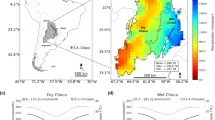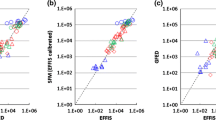Abstract
Forest fires are an integral part of the ecology of the Mediterranean Basin; however, fire incidence has increased dramatically during the past decades and fire is expected to become more prevalent in the future due to climate change. Fuel modification by prescribed burning reduces the spread and intensity potential of subsequent wildfires. We used the most recently published data to calculate the average annual wildfire CO2 emissions in France, Greece, Italy, Portugal and Spain following the IPCC guidelines. The effect of prescribed burning on emissions was calculated for four scenarios of prescribed burning effectiveness based on data from Portugal. Results show that prescribed burning could have a considerable effect on the carbon balance of the land use, land-use change and forestry (LULUCF) sector in Mediterranean countries. However, uncertainty in emission estimates remains large, and more accurate data is needed, especially regarding fuel load and fuel consumption in different vegetation types and fuel layers and the total area protected from wildfire per unit area treated by prescribed burning, i.e. the leverage of prescribed burning.

Similar content being viewed by others
References
Ager AA, Vaillant NM, Finney MA (2010) A comparison of landscape fuel treatment strategies to mitigate wildland fire risk in the urban interface and preserve old forest structure. Forest Ecology and Management 259:1556–1570
Albuquerque JPM (1961) Divisão regional do Continente Português. Agricultura 9:1–11
Andreae MO, Merlet P (2001) Emission of trace gases and aerosols from biomass burning. Global Biogeochemical Cycles 15(4):955–966
Andrews PL, Bevins CD, Seli RC (2008) BehavePlus Fire Modeling System, version 4.0: user’s guide. USDA Forest Service, Rocky Mountain Research Station, General Technical Report RMRS-GTR-106WWW Revised, Ogden
Arno SF, Brown JK (1989) Managing fire in our forests—time for a new initiative. Journal of Forestry 87(12):44–46
Boer MM, Sadler RJ, Wittkuhn RS, McCaw L, Grierson PF (2009) Long-term impacts of prescribed burning on regional extent and incidence of wildfires—evidence from 50 years of active fire management in SW Australian forests. Forest Ecology and Management 259(1):132–142
Bradstock RA, Williams RJ (2009) Can Australian fire regimes be managed for carbon benefits? New Phytologist 183:931–934
Camia A, Amatulli G (2009) Weather factors and fire danger in the Mediterranean. In: Chuvieco E (ed) Earth observation of wildland fires in Mediterranean ecosystems. Springer, Berlin, pp 71–82
Carrión JS, Sánches-Gómez P, Mota JF, Yll J, Chaín C (2003) Holocene vegetation dynamics, fire and grazing in the Sierra de Gádor, Southern Spain. The Holocene 13(6):839–849
Carvalho A, Monteiro A, Flannigan M, Solman S, Miranda A, Borrego C (2007) Forest fire emissions under climate change: impact on air quality. In: Seventh symposium on fire and forest meteorology, Extended abstract. http://ams.confex.com/ams/7firenortheast/techprogram/paper_126854.htm
Carvalho A, Flannigan M, Logan K, Gowman L, Miranda A, Borrego C (2010) The impact of spatial resolution on area burned and fire occurrence projections in Portugal under climate change. Climatic Change 98:177–197
Collins BM, Miller JM, Thode AE, Kelly M, van Wagtendonk JW, Stephen SL (2009) Interactions among wildland fires in a long-established Sierra Nevada natural fire area. Ecosystems 12:114–128
De Groot WJ, Landry R, Kurz WA, Anderson KR, Englefield P, Frase RH, Hall RJ, Banfield E, Raymond DA, Decker V, Lynham TJ, Pritchard JM (2007) Estimating direct carbon emissions from Canadian wildland fires. International Journal of Wildland Fire 16:593–606
Defossé GE, Loguercio G, Oddi FJ, Molina, JC, Kraus PD (2011) Potential CO2 emissions mitigation through forest prescribed burning: a case study in Patagonia, Argentina. Forest Ecology and Management. doi:10.1016/j.foreco.2010.11.021
European Commission (2009) Forest Fires in Europe 2008. JRC Scientific and Technical Reports No 9
FAO (2005) Global Forest Resources Assessment (FRA) 2005. http://www.fao.org/forestry/fra/fra2005/en/. Accessed 3 Jan 2011
FCCC (2006) Report of the individual review of the greenhouse gas inventory of Portugal submitted in 2005. FCCC/ARR/2005/PRT. http://unfccc.int/resource/docs/2006/arr/prt.pdf. Accessed 17 Feb 2010
Fernandes PM (2008) Forest fires in Galicia (Spain): the outcome of unbalanced fire management. Journal of Forest Economics 14:155–157
Fernandes PM (2009) Examining fuel treatment longevity through experimental and simulated surface fire behaviour: a maritime pine case study. Canadian Journal of Forest Research 39:2529–2535
Fernandes P, Botelho H (2003) A review of prescribed burning effectiveness in fire hazard reduction. International Journal of Wildland Fire 12:117–128
Fernandes P, Botelho H (2004) Analysis of prescribed burning practice in the pine forest of northwestern Portugal. Journal of Environmental Management 70:15–26
Fernandes P, Loureiro C, Botelho H (2004) Fire behavior and severity in a maritime pine stand under differing fuel conditions. Annals of Forest Science 61:537–544
Fernandes P, Botelho H, Rego F, Loureiro C (2009) Empirical modelling of surface fire behaviour in maritime pine stands. International Journal of Wildland Fire 18:698–710
Finney MA (2001) Design of regular landscape fuel treatment patterns for modifying fire growth and behavior. Forest Science 47(2):219–228
Finney MA (2003) Calculation of fire spread rates across random landscapes. International Journal of Wildland Fire 12:167–174
Finney MA, McHugh CW, Grenfell IC (2005) Stand- and landscape-level effects of prescribed burning on two Arizona wildfires. Canadian Journal of Forest Research 35:1714–1722
Finney MA, Seli RC, McHugh CW, Ager AA, Bahro B, Agee JK (2007) Simulation of long-term landscape-level fuel treatment effects on large wildfires. International Journal of Wildland Fires 16:712–727
Flannigan MD, Harrington JB (1988) A study of the relation of meteorological variables to monthly provincial area burned by wildfire in Canada 1953–80. Journal of Applied Meteorology 27:441–452
Galiana L, Lázaro A (2010) Potential barriers and factors for success. In: Montiel C, Kraus D (eds) Best practices of fire use—prescribed burning and suppression fire programmes in selected case-study regions in Europe. European Forest Institute Research Report 24, Joensuu, pp 155–162
IPCC (2006) In: Eggleston HS, Buendia L, Miwa K, Ngara T, Tanabe K (eds.) 2006 IPCC guidelines for national greenhouse gas inventories, prepared by the National Greenhouse Gas Inventories Programme. Volume 4. Agriculture, forestry and other land use. IGES, Japan
IPCC (2007) In: Parry ML, Canziani OF, Palutikof JP, van der Linden PJ, Hanson CE (Eds) Contribution of Working group II to the fourth assessment report of the intergovernmental panel on climate change. Cambridge University Press, Cambridge
Ito A, Penner JE (2004) Global estimates of biomass burning based on satellite imagery for the year. Journal of Geophysical Research 109:D14S05
Keeley JE (2002) Fire management of California shrubland landscapes. Environmental Management 29:395–408
Lázaro A (2010) Development of prescribed burning and suppression fire in Europe. In: Montiel C, Kraus D (eds) Best practices of fire use—prescribed burning and suppression fire programmes in selected case-study regions in Europe. European Forest Institute Research Report 24, Joensuu, pp 17–31
Lindner M, Maroschek M, Netherer S, Kremer A, Barbati A, Garcia-Gonzalo J, Seidl R, Delzon S, Corona P, Kolström M, Lexer MJ, Marchetti M (2010) Climate change impacts, adaptive capacity, and vulnerability of European forest ecosystems. Forest Ecology and Management 259:698–709
Loehle C (2004) Applying landscape principles to fire hazard reduction. Forest Ecology and Management 198:261–267
MCPFE (2007) State of Europe’s forests 2007. The MCPFE report on sustainable forest management in Europe 2007
Miranda AI, Borrego C, Sousa M, Valente J, Barbosa P, Carvalho A (2005) Model of forest fire emissions to the atmosphere. Deliverable D252 of SPREAD Project (EVG1-CT-2001-00043). Department of Environment and Planning, University of Aveiro AMB-QA-07/2005, Aveiro
Miranda AI, Marchi E, Ferretti M, Millán MM (2009) Forest fires and air quality issues in Southern Europe. In: Bytnerowicz A, Arbaugh M, Riebau A, Andersen C (eds) Wildland fires and air pollution, developments in environmental science, vol 8. Elsevier, Amsterdam, pp 209–232
Mitchell SR, Harmon ME, O’Connell KEB (2009) Forest fuel reduction alters fire severity and long-term carbon storage in three Pacific Northwest ecosystems. Ecological Applications 19(3):643–655
Narayan C, Fernandes P, van Brusselen J, Schuck A (2007) Potential for CO2 emissions mitigation in Europe through prescribed burning in the context of the Kyoto Protocol. Forest Ecology and Management 251:164–173
North M, Hurteau M, Innes J (2009) Fire suppression and fuels treatment effects on mixed-conifer carbon stocks and emissions. Ecological Applications 19(6):1385–1396
Nunes MCS, Vasconcelos MJ, Pereira JMC, Dasgupta N, Alldredge RJ, Rego FC (2005) Land cover type and fire in Portugal: do fires burn land cover selectively? Landscape Ecology 20:661–673
Pausas J (2004) Changes in fire and climate in the Eastern Iberian Peninsula (Mediterranean Basin). Climatic Change 63:337–350
Pausas J, Llovet J, Rodrigo A, Vallejo R (2008) Are wildfires a disaster in the Mediterranean basin? A review. International Journal of Wildland Fire 17:713–723
Pinol J, Terradas J, LLoret F (1998) Climate warming, wildfire hazard, and wildfire occurrence in coastal Eastern Spain. Climatic Change 38:345–357
Pinol J, Beven K, Viegas DX (2005) Modelling the effect of fire-exclusion and prescribed fire on wildfire size in Mediterranean ecosystems. Ecological Modelling 183:397–409
Pinol J, Castellnou M, Beven KJ (2007) Conditioning uncertainty in ecological models: assessing the impact of fire management strategies. Ecological Modelling 207:34–44
Price O, Bradstock R (2011) Quantifying the influence of fuel-age and weather on the annual extent of unplanned fires in the Sydney region of Australia. International Journal of Wildland Fire 20:142–151
Reinhard ED, Keane RE, Brown JK (1997) First order fire effects model: FOFEM 4.0 user’s guide. USDA Forest Service General Technical Report INT-GTR-344
Seiler W, Crutzen PJ (1980) Estimates of gross and net fluxes of carbon between the biosphere and the atmosphere from biomass burning. Climatic Change 2:207–247
Smith JE, Heath LS (2002) A model of forest floor carbon mass for United States forest types. USDA Forest Service Research Paper NE-722
Sorensen CD, Finkral AJ, Kolb TE, Huang CH (2011) Short- and long-term effects of thinning and prescribed fire on carbon stocks in ponderosa pine stands in northern Arizona. Forest Ecology and Management 261:460–472
Stephens SL, Moghaddas JJ (2005) Experimental fuel treatment impacts on forest structure, potential fire behavior, and predicted tree mortality in a California mixed conifer forest. Forest Ecology and Management 215:21–36
Stephens SL, Moghaddas JJ, Hartsough BR, Moghaddas E, Clinton NE (2009) Fuel treatment effects on stand-level carbon pools, treatment-related emissions, and fire risk in a Sierra Nevada mixed-conifer forest. Canadian Journal of Forest Research 39:1538–1547
UNFCCC National Inventory Submissions (2009) http://unfccc.int/national_reports/annex_i_ghg_inventories/national_inventories_submissions/items/4771.php. Accessed 21 Sep 2009
Van Wagner C (1987) Development and structure of the Canadian Forest Fire Weather Index System. Canadian Forestry Service, Forestry Technical Report 35, Ottawa
Vilén T, Meyer J, Thürig E, Lindner M, Green T (2005) Improved regional and national level estimates of the carbon stock and stock change of tree biomass for six European countries (Deliverable 6.1 of the CarboInvent Project). CarboInvent Deliverable 6.2, European Forest Institute, Joensuu
Wiedinmyer C, Hurteau MD (2010) Prescribed fire as a means of reducing forest carbon emissions in the Western United States. Environmental Science and Technology 44:1926–1932
Acknowledgments
This study is part of the project ‘FIRE PARADOX—an Innovative Approach to Integrated Wildland Fire Management Regulating the Wildfire Problem by the Wise Use of Fire: Solving the Fire Paradox’, funded by the European Commission (contract FP6-018505). The reviewing process brought significant improvements to this paper.
Author information
Authors and Affiliations
Corresponding author
Rights and permissions
About this article
Cite this article
Vilén, T., Fernandes, P.M. Forest Fires in Mediterranean Countries: CO2 Emissions and Mitigation Possibilities Through Prescribed Burning. Environmental Management 48, 558–567 (2011). https://doi.org/10.1007/s00267-011-9681-9
Received:
Accepted:
Published:
Issue Date:
DOI: https://doi.org/10.1007/s00267-011-9681-9




